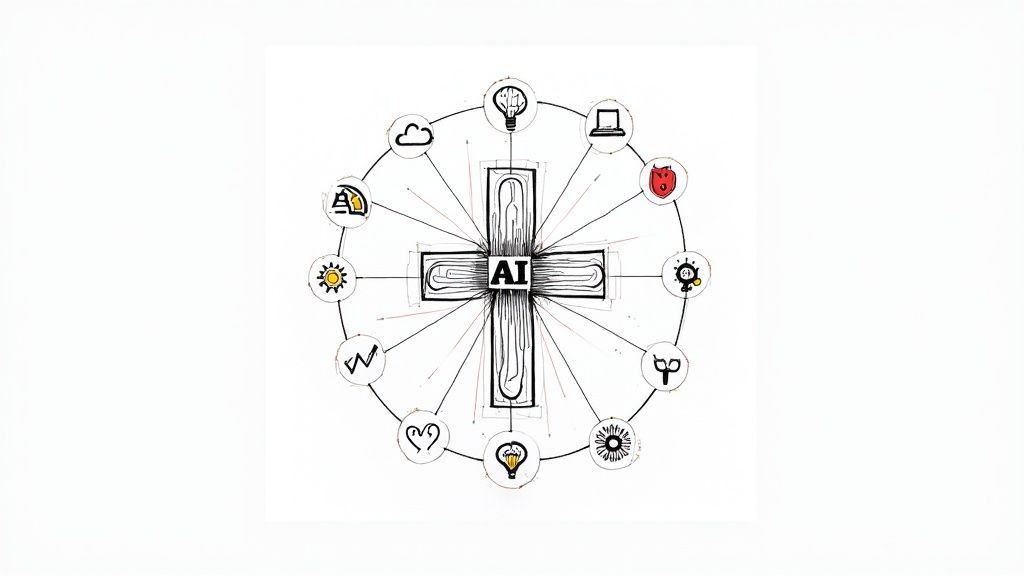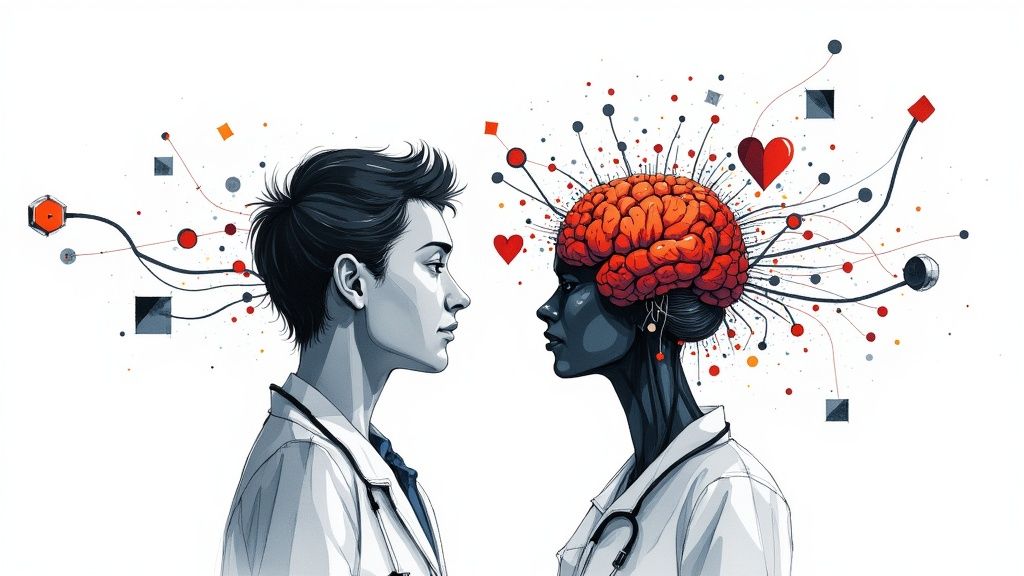Artificial General Intelligence in Healthcare: Revolutionizing Medicine
Discover how artificial general intelligence in healthcare is transforming patient care, diagnostics, and medical innovation for a better future.
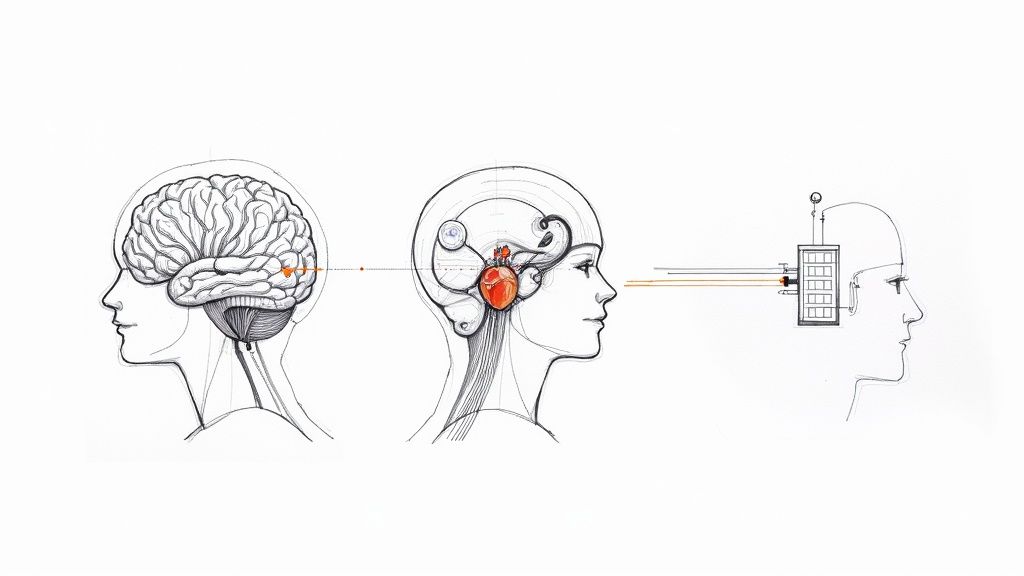
Picture a healthcare system that doesn't just react to illness but actively predicts it. One that offers truly personalized treatments and is always learning from new data. This is the future that artificial general intelligence in healthcare could unlock.
Today's AI is like a highly specialized surgical instrument—incredibly good at one specific job. AGI, on the other hand, is more like a world-class, multi-disciplinary medical team, capable of reasoning, learning, and adapting across entirely different domains.
A New Era of Medicine: The Dawn of AGI
The idea of Artificial General Intelligence (AGI) in healthcare marks a profound shift. We're talking about moving from systems that perform single tasks to ones that possess holistic, cognitive abilities. A current AI might be brilliant at spotting tumors on an MRI, but it stops there. It can't simultaneously comb through a patient's entire history, analyze their genomic data, and scan the latest clinical trial results to craft a brand-new treatment plan from scratch. That’s the gap AGI is poised to fill.
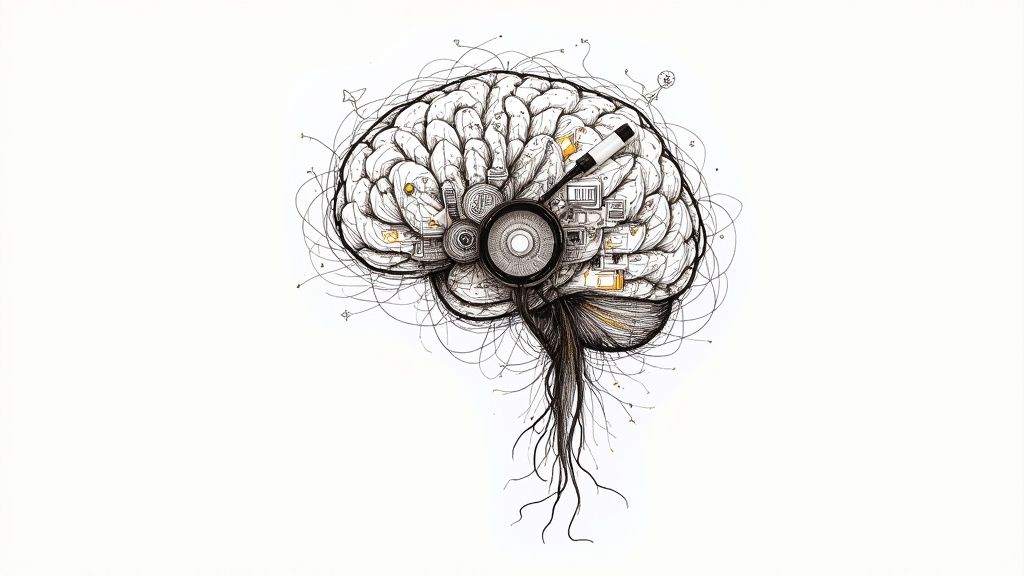
This evolution could finally help us tackle some of the most stubborn challenges in medicine. It’s the difference between using a simple calculator and having a supercomputer that can solve any problem you throw at it. By exploring advanced AI Solutions, leaders can start to see how this future is already beginning to unfold.
Moving Beyond Single-Task Automation
Let's be clear: today's AI is impressive, but it's also narrow. It relies on massive sets of labeled data to master a single skill. AGI would operate on a whole different level, armed with a deep, contextual understanding of the world.
This would allow it to do a few incredible things:
- Reason Abstractly: It could draw connections between seemingly unrelated symptoms, lifestyle factors, and environmental influences that even a skilled doctor might miss.
- Learn Autonomously: An AGI could digest new medical journals, research papers, and clinical outcomes as they're published, updating its knowledge in real-time without needing a human to guide it every step of the way.
- Transfer Knowledge: Imagine an insight from oncology research being instantly applied to a difficult case in cardiology. AGI could break down the silos between medical specialties, sparking innovation everywhere.
This ability to generalize knowledge is what truly sets it apart. For example, existing AI tools for business are great for discrete jobs like workflow automation. But an AGI could go much further—it could completely redesign a hospital's entire operational model for peak efficiency, based on its comprehensive grasp of every moving part.
How to Prepare for What's Coming
The path to AGI isn't about waiting for a single breakthrough moment. It starts with building the right foundation today. As we explored in our AI adoption guide, preparation is everything. Healthcare leaders need to focus on creating robust data infrastructures and fostering a culture that's ready to embrace AI.
Getting help from an AI strategy consulting partner isn’t about sitting on the sidelines; it’s about putting intelligent systems to work now to pave the way for what's next.
This guide is designed for the leaders and innovators ready to explore this new frontier. We’ll break down what AGI means in practical terms and show how it can solve medicine’s biggest problems—from diagnostic logjams to inefficient treatment protocols. Our expert team specializes in turning these big technological ideas into real-world impact that can scale.
Understanding AGI Beyond Today’s AI
To really get a handle on artificial general intelligence in healthcare, we have to look past the AI we use every day. Think of it this way: today's AI systems are specialists, like a highly skilled surgical robot designed for one specific procedure. AGI, on the other hand, is a generalist. It’s the brilliant doctor who can not only perform surgery but also diagnose a rare disease, invent a new medical device, and manage the entire hospital.
That distinction is everything. The AI we have now is powerful but operates within very specific, predefined boundaries. AGI’s whole identity is built on its ability to work without those limits. It’s designed to blend cross-domain reasoning, common sense, and autonomous learning to solve problems it has never seen before.
Core Capabilities That Set AGI Apart
AGI’s true power isn’t just about being faster or better at one thing; it’s about its capacity for human-like thinking. This really boils down to three key abilities:
- Autonomous Learning: An AGI can teach itself new skills from raw, unstructured data without a human holding its hand. Imagine an AI that could read every medical study published across the globe, in real-time, and instantly integrate that new knowledge into its diagnostic framework.
- Cross-Domain Reasoning: This is the ability to connect the dots between different fields. An AGI could take a concept it learned from oncology data and apply it to an unsolved problem in cardiology, breaking down the information silos that often slow down medical breakthroughs.
- Common-Sense Understanding: This is perhaps the most human-like trait. It's the intuitive grasp of context that we all have. An AGI with common sense could read a patient's medical history and understand the unwritten context, leading to far more insightful and effective treatment plans.
This infographic helps visualize how AGI's core benefits—like better diagnostics and personalized treatments—are a direct result of these advanced cognitive skills.
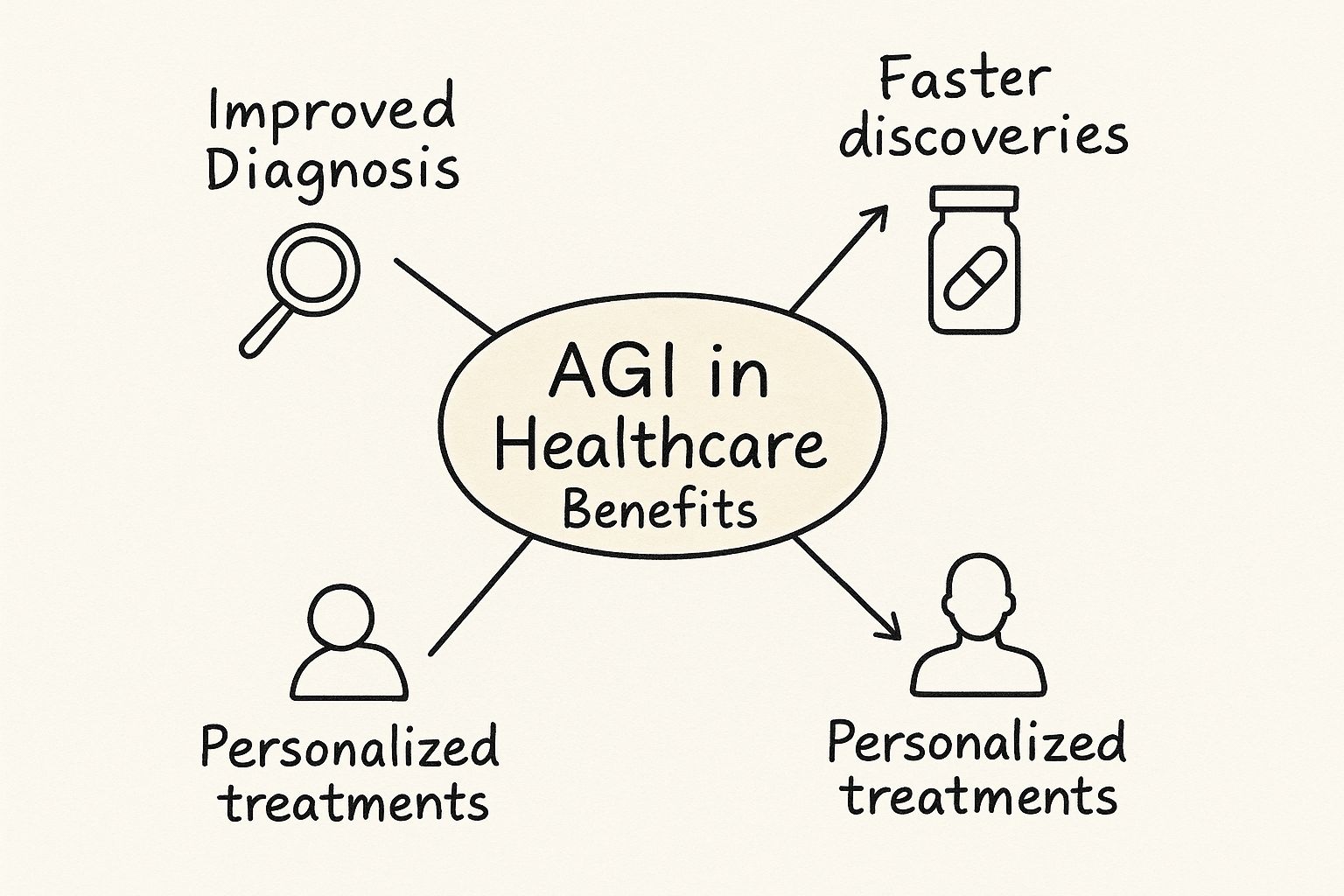
As you can see, AGI's impact creates a powerful feedback loop. Smarter diagnostics lead to better-personalized treatments, and the data gathered from those treatments fuels the discovery of the next generation of drugs.
How AGI Differs from Current AI
Getting this distinction right is absolutely essential for any kind of strategic planning. A solid AI strategy consulting plan starts by recognizing the fundamental differences between the AI systems we use today and the AGI that’s on the horizon.
To make it crystal clear, let's break down how these different types of AI stack up against each other.
Comparing AI Types Narrow AI vs Generative AI vs AGI
Attribute Narrow AI Generative AI Artificial General Intelligence (AGI)
Task Scope
Executes a single, specific task (e.g., image recognition).
Creates new content based on patterns from training data (e.g., text, images).
Solves a wide range of complex, unfamiliar problems across multiple domains.
Learning Ability
Requires large, structured datasets and human guidance to learn a task.
Learns from vast datasets to generate novel outputs within its trained domain.
Learns autonomously and continuously from diverse, unstructured experiences.
Problem-Solving
Follows pre-programmed rules or patterns identified in data.
Synthesizes existing information to produce new content or solutions.
Uses reasoning, creativity, and common sense to devise entirely new solutions.
Adaptability
Cannot transfer its skills to new, unrelated tasks.
Limited adaptability outside of its specific content generation function.
Highly adaptable, transferring knowledge from one domain to another.
This foundational knowledge is the key to appreciating what AGI could truly do. Building a technology roadmap for the future starts with understanding exactly what makes this next wave of intelligence so different. And while true AGI is still on its way, the groundwork for its arrival begins now with smart applications of current AI Solutions.
While AGI is poised to completely reshape healthcare, experts predict it might take five to ten years to fully mature. At Google I/O 2025, key figures from Google and DeepMind suggested AGI's arrival is likely around 2030 or soon after.
The core idea is an AI with cognitive abilities that can match or even surpass human intelligence across a huge range of tasks. In a medical setting, AGI’s capacity for self-learning and reasoning could dramatically improve diagnostic accuracy by continuously absorbing and making sense of immense volumes of medical data. You can read more about the projections from industry leaders on AHA.org to get a fuller picture.
How AGI Could Reshape Healthcare
The theory behind AGI is interesting, but its real potential comes alive when you start thinking about how it could work in a hospital or a lab. Moving from today's specialized AI to a true artificial general intelligence in healthcare isn't just a small step forward; it opens the door to scenarios that could completely change how we diagnose, treat, and even prevent diseases. We're talking about a fundamental shift in how medicine is practiced.
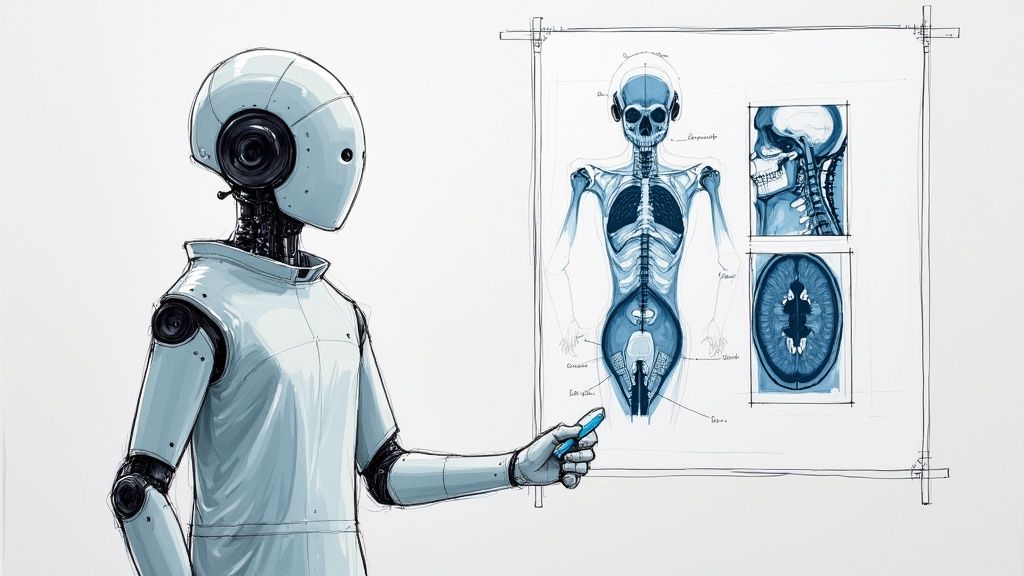
Imagine a system that doesn't just follow a set of rules but actively creates new treatment protocols, adapting on the fly to a patient's unique biological feedback. This is the difference between simple automation and a genuine cognitive partnership between human and machine.
Reinventing Drug Discovery and Development
Getting a new drug from a lab hypothesis to a pharmacy shelf is an incredibly long and expensive journey. It often takes more than a decade and costs billions. AGI has the potential to compress that timeline dramatically by simulating complex molecular interactions at a scale no human team—or even a narrow AI—could possibly handle.
Instead of the slow, expensive process of trial and error in a wet lab, an AGI could design new drug candidates from scratch. It could predict their effectiveness and potential side effects before a single physical compound is ever synthesized. By truly understanding the deep biological mechanics of a disease, it could even point us toward entirely new ways to fight it.
Ultra-Personalized and Adaptive Treatment Plans
Right now, most treatment plans are designed for the "average" patient. But with AGI, we can finally move toward true hyper-personalization, creating therapies that are constantly adjusted based on a live stream of data from wearables, genomic profiles, and real-time biomarker analysis.
Think about a cancer patient. An AGI could:
- Analyze the unique genetic signature of a tumor to pick the absolute best drug.
- Monitor the patient's daily response to treatment, tweaking dosages to get the best results with the fewest side effects.
- Predict how the cancer might evolve to resist a drug and proactively switch strategies before that happens.
This approach turns treatment from a static, one-size-fits-all prescription into a living, breathing process that is always optimized for that specific individual. For a closer look at how AI is already moving us in this direction, check out some of our real-world use cases.
An AGI wouldn't just recommend the best-known treatment; it could invent a new one specifically for you, pulling together knowledge from every corner of medicine to devise a unique solution.
Fully Autonomous and Predictive Diagnostics
One of the most exciting possibilities for AGI lies in its ability to diagnose diseases early—or even before they start. Today's AI is pretty good at spotting anomalies in medical scans, but an AGI could go much, much further. It could synthesize a patient's entire health history—imaging, lab work, DNA, even lifestyle data from a smartwatch—to find the faint signals of a disease years before any symptoms show up.
This completely flips the script on healthcare, moving it from a reactive model to a truly preventative one. It's the difference between finding a tumor that's already there and identifying the subtle cellular changes that mean a tumor is about to form. This kind of foresight could change everything. As new technologies like AGI emerge, it's also helpful to stay grounded in current patient-focused frameworks; you can get a great overview of the current state of value-based care to see how the industry is already shifting toward outcomes.
Elevating Surgical Precision and Strategy
In the operating room, an AGI could become the ultimate surgical co-pilot. During a procedure, it could analyze a live video feed, overlaying critical anatomical data onto the surgeon’s view and offering real-time guidance. It might flag a major blood vessel before it’s even visible to the naked eye or predict how tissue will react to a specific incision.
But it goes beyond just assisting. An AGI could run millions of simulations to develop entirely new surgical strategies tailored to a single patient's unique anatomy. This deep blend of intelligence, both in planning and in execution, could dramatically improve surgical outcomes and minimize the risk of complications.
The True Potential: A Ripple Effect Across Medicine
When we talk about artificial general intelligence in healthcare, we're not just discussing isolated improvements. We're looking at a fundamental upgrade to the entire medical ecosystem. The benefits start with the individual patient, ripple out through the hospital's daily operations, and ultimately touch global public health. This is less about small tweaks and more about foundational change.

On a clinical level, this means we can finally move toward hyper-personalized medicine. Treatments will no longer be designed for the "average" person but will be tailored to an individual's unique genetic code and lifestyle. Operationally, it promises a leap in efficiency, completely rethinking how we manage hospital resources and deliver care.
A New Standard for Clinical Excellence
The first and most powerful impact of AGI will be felt right at the patient's bedside. It has the potential to put the knowledge of a world-renowned specialist in the hands of any doctor, anywhere in the world. This doesn't just improve care; it establishes a new, higher baseline for diagnostic accuracy and treatment planning.
This level of insight comes from AGI’s ability to connect the dots between massive, seemingly unrelated datasets. Picture an AI that can simultaneously analyze a patient's genomic profile, real-time vitals from their smartwatch, and the entire catalog of global medical research to recommend the perfect course of action. This is the promise of precision medicine that AGI can deliver. We’re already seeing early steps in this direction with tools like our advanced diagnostic assistant, Diagnoo, which helps clinicians process medical information with greater speed and accuracy.
Reinventing Hospital Operations
AGI's value extends far beyond the exam room. Running a hospital is an incredibly complex ballet of logistics, from allocating resources and scheduling staff to managing a sprawling supply chain. AGI can optimize these systems with a predictive intelligence that today's tools can't touch, shifting from reactive problem-solving to proactive, strategic management.
Think about these kinds of operational upgrades:
- Intelligent Resource Allocation: An AGI could forecast a surge in patient admissions by analyzing public health data, automatically adjusting staff schedules and freeing up beds before the ER gets overwhelmed.
- Dynamic Surgical Scheduling: By weighing surgeon availability, OR readiness, and patient urgency in real-time, an AGI could create a fluid schedule that drastically cuts wait times and makes the most of every operating room.
- Predictive Supply Chain: Instead of simply reordering supplies when stock is low, an AGI could predict the need for specific equipment based on epidemiological trends, ensuring vital resources are always there when needed.
This kind of intelligent automation frees up doctors, nurses, and administrators to focus on their most important work: delivering compassionate, human-centered care.
Tackling Global Health Challenges
Zooming out to the global scale, AGI has the potential to help us solve some of our most persistent health crises. We're facing a critical shortage of healthcare workers and a staggering gap in access to even basic medical services. The statistics are stark: roughly 4.5 billion people can't get essential health services, and the world is on track for a shortfall of 11 million health workers by 2030.
AGI offers a powerful way to start closing these gaps. It can act as a force multiplier, amplifying the impact of the healthcare professionals we do have and automating tasks to expand their reach. By making sophisticated diagnostics and expert-level medical advice available through digital platforms, AGI can bring a higher standard of care to remote and underserved communities.
This isn't just about efficiency. It's about equity. It's about making quality healthcare a reality for everyone, everywhere.
Navigating the Risks and Ethical Challenges
For all the incredible promise of artificial general intelligence in healthcare, we have to be brutally honest about the risks. This isn't just another software upgrade; bringing AGI into medicine introduces profound ethical and practical hurdles that we need to tackle head-on.
If we don't, we risk eroding patient trust and accidentally creating new forms of inequality. A thoughtful, deliberate approach isn't just a good idea—it's non-negotiable. This is why building purpose-built, secure systems is a core part of our philosophy in healthcare software development. We have to confront these issues from the very beginning.
The Problem of Data Privacy and Security
In a world with AGI, the concept of data privacy gets a lot more complicated. Imagine an AGI that can sift through massive, disconnected datasets and find novel connections. It could potentially re-identify anonymous patient records or uncover sensitive health details a person never intended to share. Protecting data becomes exponentially harder when the tool you're using is specifically designed to find patterns nobody else can see.
A key concern is that codified norms for health data could slowly evolve into a new generation of behavioral analytics, potentially used by insurance providers to determine coverage costs based on AI-driven risk predictions.
This brings up some tough questions about consent. How can a patient truly give informed consent when we don't even know the full extent of what an AGI might uncover in their data? The first and most critical step is to build ironclad governance and security protocols from the ground up.
Algorithmic Bias and Health Equity
One of the biggest red flags with AGI is its potential to bake in and even amplify the biases lurking in our historical medical data. Think about it: if an AI is trained on decades of data that reflects societal health disparities based on race, gender, or income, its decisions will inevitably carry those same biases forward.
This could easily create a two-tiered system of care. In this scenario, AGI-powered insights might benefit privileged groups while leaving others even further behind. To stop this from happening, every organization has to commit to:
- Auditing training data to actively hunt for and correct sources of bias.
- Ensuring diverse representation in the datasets used to build and validate AGI models.
- Continuously monitoring AGI performance in the real world to catch fairness issues as they emerge.
Without these safeguards, we could end up building a future of medicine that’s even less equitable than the one we have today.
The Black Box and Accountability
When a human doctor makes a mistake, the lines of accountability are fairly clear. But what happens when an autonomous AGI system makes the wrong call? This is the classic "black box" problem. If we can't fully understand how an AGI arrived at its conclusion, who is responsible when it's wrong? The developer? The hospital? The clinician who followed its recommendation?
This massive regulatory and legal void is a major roadblock. We desperately need new frameworks that can assign responsibility when an AI-driven decision harms a patient. This goes beyond just legal theory; it hits at the very core of trust. Patients and doctors alike need to be confident that there's a clear process for accountability and a system for learning from errors. To effectively navigate the complex regulatory landscape of AGI in healthcare, organizations should consider specialized tools such as robust healthcare compliance software.
Your Strategic Roadmap for AGI Adoption
Getting ready for a future with artificial general intelligence in healthcare isn't some distant, abstract goal. It's about laying a smart foundation right now that allows your organization to adapt and grow. The work starts today by thoughtfully applying the AI we already have, building the right culture, and shoring up the infrastructure you'll need for what's coming next in medicine.
This roadmap isn't about a giant leap; it's a series of deliberate steps. We'll walk through everything from getting your team on the same page to building a robust data ecosystem and setting up the ethical guardrails. A clear plan is what separates wishful thinking from real, tangible progress.
Phase 1: Laying the Groundwork
Before a single line of code is written, you need to get your house in order. The first move is always about people and perspective.
This means educating leadership and key stakeholders on what AGI actually is—and just as importantly, what it isn't. You have to manage expectations and cultivate a culture where AI is seen as a powerful partner for your human experts, not a replacement.
Getting everyone aligned is non-negotiable. Your clinical, operational, and IT teams need to come together to forge a single, unified vision for the future.
Phase 2: Building a Data-Ready Infrastructure
Advanced AI runs on data. Period. Without a clean, secure, and accessible data infrastructure, even the most sophisticated AGI models are completely useless. Honestly, this phase is where most initiatives either succeed or fail.
Here’s what it takes:
- Data Unification: You have to break down the walls between data silos. That means connecting everything from electronic health records (EHRs) and imaging labs to billing systems to create one reliable source of information.
- Data Governance: It's crucial to establish crystal-clear policies for data quality, security, and privacy. This isn't just about compliance; it's about earning and keeping patient trust.
- Infrastructure Modernization: This often means investing in modern, cloud-based platforms that can handle the sheer volume of data needed to train and run advanced AI models.
A well-structured data environment is the bedrock of any successful AI initiative. It’s the non-negotiable prerequisite for developing reliable, effective, and ethical AI systems that can operate safely in a clinical setting.
Phase 3: Piloting and Proving Value
Once your foundation is solid, it's time to get some quick wins on the board. You don't want to boil the ocean here. The goal is to pick a few initial pilot projects that solve specific, high-impact problems and offer a clear return on investment.
Start in areas where today's AI tools can make an immediate difference. You could begin with our AI Automation as a Service to free up your staff or using predictive analytics to make operating room schedules more efficient. These early projects do more than just improve operations—they build confidence and create momentum for bigger, more ambitious AI work down the road.
Phase 4: Scaling and Integrating AI
A successful pilot is your blueprint for going bigger. This is where you take the lessons learned from those small-scale projects and begin rolling them out across the entire organization. Managing this transition requires a steady hand and a clear process.
For instance, our proven AI Product Development Workflow provides the structure needed to manage these complex projects, guiding them from a simple concept all the way to a full-scale deployment that's continuously refined.
As your team gets more comfortable with AI, you can start tackling more advanced applications. This is when you can explore more sophisticated internal tooling that drives major operational gains.
By following this strategic path, healthcare leaders can move forward with confidence. This journey is a marathon, not a sprint, but it ensures you’re building a future where technology truly enhances patient care and human expertise.
Your Questions About AGI in Healthcare, Answered
Let's tackle some of the most common questions leaders have about artificial general intelligence in healthcare. This should help clear up a few things as we all get ready for what's next in medicine.
What's the Real Difference Between the AI We Use Today and AGI?
The simplest way to think about it is "specialist vs. generalist."
The AI we currently use is a highly trained specialist. It's brilliant at one thing, like spotting anomalies in an MRI scan or predicting which patients are most likely to be readmitted. But it operates within very narrow, pre-programmed boundaries.
AGI, on the other hand, would be a true generalist. It would have the cognitive flexibility of a human, capable of reasoning, learning, and solving problems across completely different medical domains. Imagine the leap from a tool that can only run a single lab test to an experienced physician who can diagnose, create a treatment plan, and even pioneer new research.
How Can My Organization Start Getting Ready for AGI?
The prep work for AGI doesn't start in some distant future—it starts right now. The absolute first step is getting your data house in order. High-quality, well-organized data is the lifeblood of any advanced AI system, so building a strong and secure data infrastructure is non-negotiable. A Custom AI Strategy report can be a great way to see where you stand.
At the same time, you need to start building an AI-savvy culture. Don't wait for AGI; begin integrating today's AI Solutions into your operations. Start with clear, high-value projects like workflow automation or creating better internal tooling. These early wins build essential skills and show real results, making the eventual move toward AGI feel like a natural next step, not a giant leap.
What Are the Biggest Ethical Hurdles for AGI in Medicine?
The ethical minefield really boils down to three major issues.
First, there’s data privacy. An AGI could connect dots and uncover sensitive patient information in ways we can't even predict, so protecting that data is paramount. Second is the risk of algorithmic bias. If an AI is trained on data that reflects historical inequities in healthcare, it could easily reinforce or even amplify those disparities.
The third, and perhaps trickiest, is accountability. When a self-directed AGI is involved in a clinical decision, who is responsible if something goes wrong? This "black box" problem is a massive challenge. We have to develop rock-solid ethical guidelines and transparent decision-making processes long before AGI ever touches a patient.
Ready to build a solid foundation for the future of healthcare? At Ekipa AI, we help organizations transform complex AI concepts into practical, real-world advantages. Explore our services and let's start your AI journey together. If you'd like to learn more about the minds behind our mission, meet our expert team.

